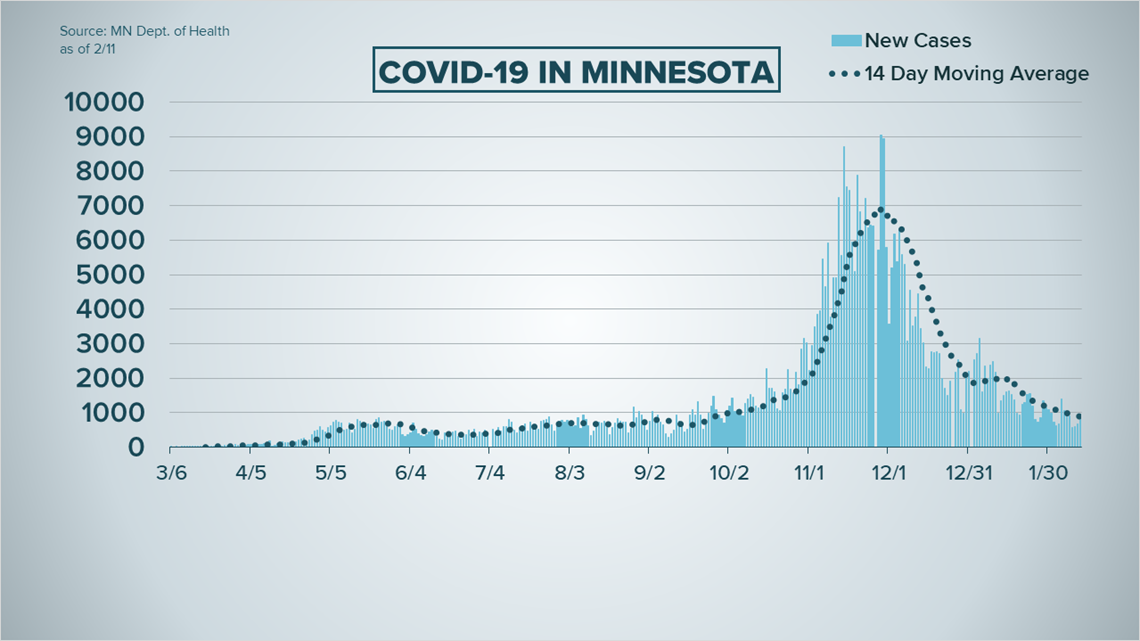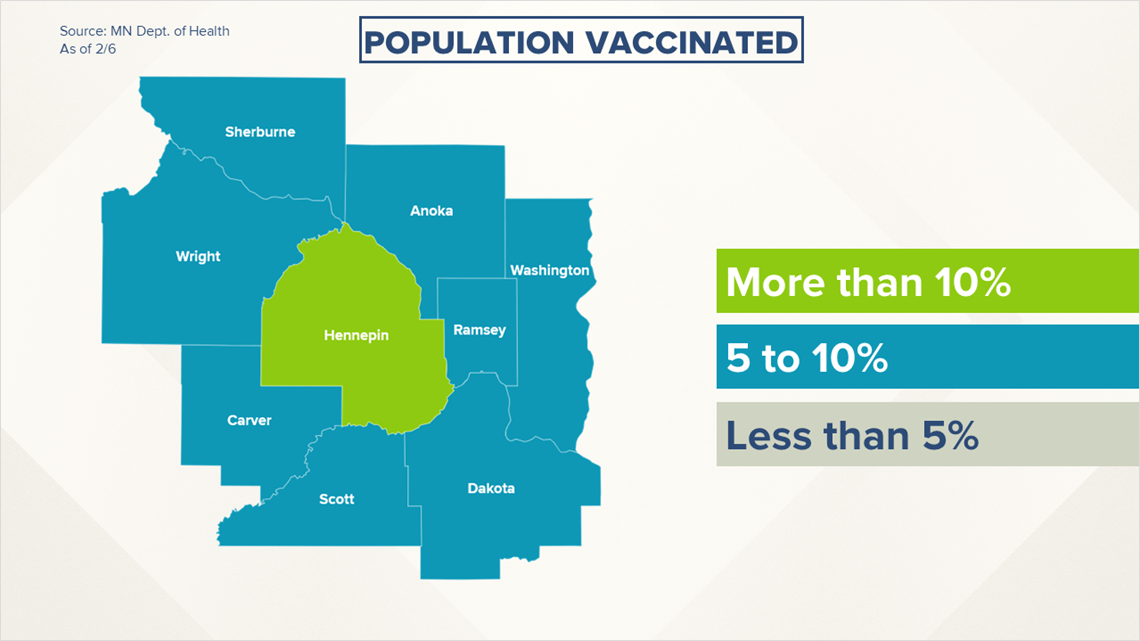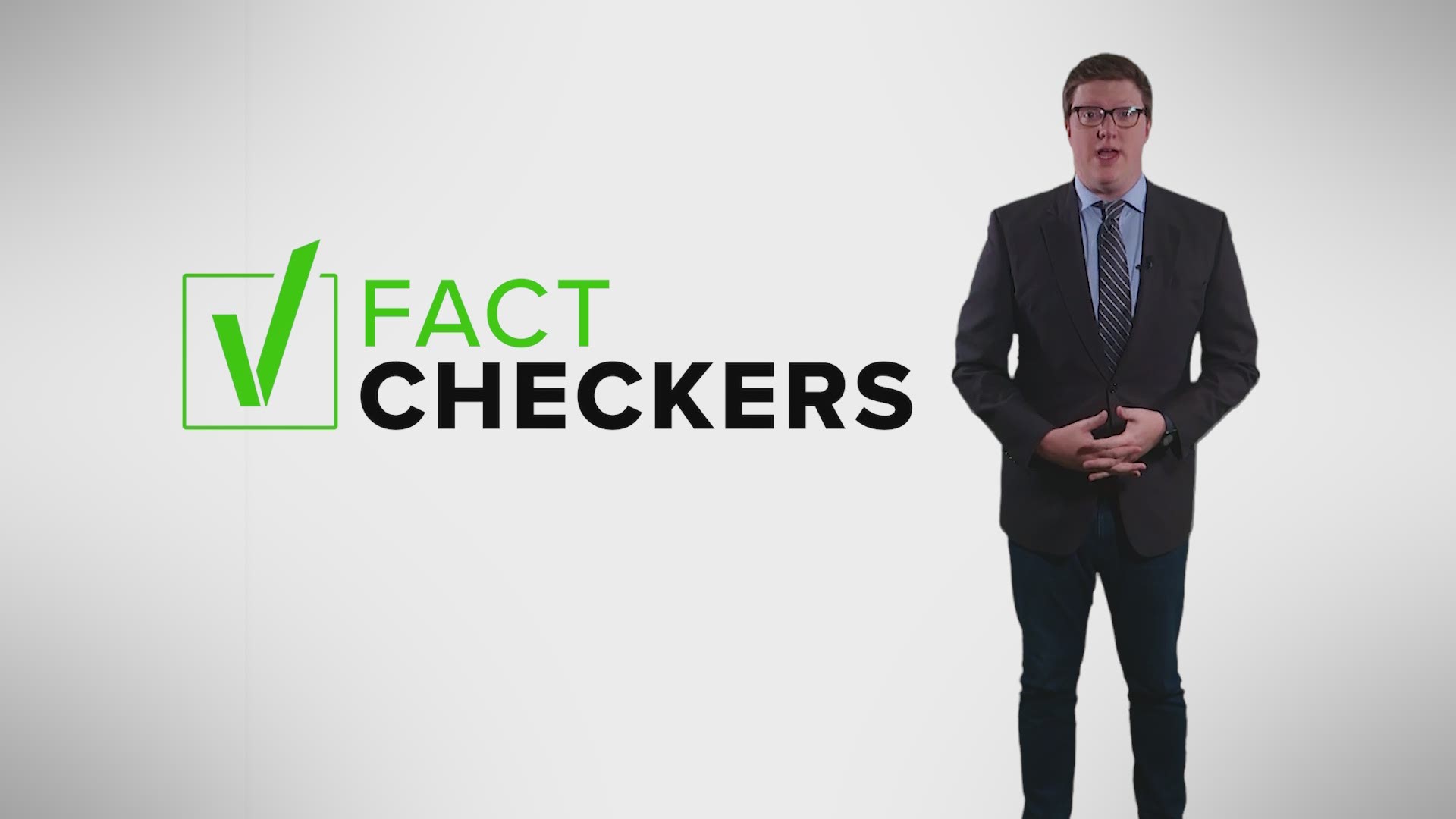ST PAUL, Minn. — Thursday, Feb. 11
- Fauci says all Americans should be eligible for COVID vaccines by April
- CDC: Fully vaccinated people don't need to quarantine after exposure
- Minnesota nears 600K with at least one dose, passes 177K with both doses
- MDH: Nearly 30% of Minnesotans 65+ have gotten at least one dose
- Delta offering rapid COVID testing at Minneapolis-St. Paul International Airport
2 p.m.
The Minnesota Department of Health (MDH) is urging the public to stay vigilant even as the state’s COVID-19 situation has improved to the most “hopeful” place since June.
MDH Commissioner Jan Malcolm said on a regular briefing call with the media Thursday that the seven-day rolling average test positivity rate is at 3.9%, which is below the caution category. This is the lowest test positivity rate MDH has seen since June 27.
“So that is a very hopeful sign,” Malcolm said.
However, Minnesota health officials still announced another 24 deaths Thursday.
Those people ranged in age from their 30s to over 100 years old, Malcolm said. She noted that the person in their 30s had underlying health conditions.
Malcolm says over 777,000 COVID-19 vaccine doses have now been administered to Minnesotans. Nearly 600,000 people have gotten at least one dose, and more than 177,000 people have gotten both doses.
“There are reasons to feel good about the overall direction that we’re headed,” said MDH Infectious Disease Director Kris Ehresmann said. “The light at the end of the tunnel is growing brighter every day.” Ehresmann added, “We can have hope that we’re on our way to ending the pandemic.”
Ehresmann said almost 30% of the 65+ population in Minnesota has had their first dose of a COVID vaccine. According to the MDH vaccine data dashboard, that's just over 251,000 people.
She said Minnesotans should remember that even if they haven’t gotten one yet, the more people who have been vaccinated, the less competition there is.
“If people can recognize that the vaccine will come and they will get that vaccine, I think that will also help to encourage them,” she said.
She said the hospitalization rates, vaccination progress and test positivity rates are all encouraging. “We’re in a better place right now than we have been in for quite some time,” she said. “But until we finally reach that goal of crushing COVID, we all need to keep our guard up.”
Ehresmann said this is especially true because of the new, faster-spreading variants. Minnesota has confirmed 18 cases of the B117 variant originating in the UK, and two cases of the P1 variant from Brazil. The U.S. has also seen nine cases of the South African variant, Ehresmann said. But the UK volume is spreading at a higher rate.
There have been more than 900 cases in total of the UK variant reported in the U.S., Ehresmann said. "There is a concern that this may become the dominant strain across much of the United States by March,” Ehresmann said.
She encouraged Minnesotans to continue to wear a mask, social distance and avoid crowded spaces. Making sure masks fit tightly and double masking are two steps to “maximizing the benefit” of your mask, Ehresmann said.
A nose wire can also help masks fit more tightly and make them more effective, Ehresmann said. The CDC has given guidance on wearing a mask more effectively on its website.
Ehrenmann also said even with the focus on vaccines, testing remains an important tool in beating the pandemic. “Because of the variants circulating we want you to be attentive,” she said. Masking, social distancing, avoiding large crowds and testing are vital, she said.
Anyone regularly interacting with people outside of their household is encouraged to get tested, in addition to anyone with symptoms. “We’re closer than ever to the end of this pandemic,” Ehresmann said. “Every COVID death we can prevent between now and then is a success story.”
Commissioner Malcolm added that vaccine supplies will likely continue to be limited in the coming months. “We really are in a race against time to vaccinate as many people as possible as quickly as possible to bring this pandemic to an end,” she said.
Minnesota’s vaccine distribution strategy is to “meet people where they are” and to reach marginalized communities that have been hit hardest by COVID-19, Malcolm said.
She said that’s why MDH is mobilizing a combination of local public health, hospitals, pharmacies and community vaccination sites.
MDH officials are still urging the public to avoid going on any winter or spring break trips.
“As tempting as it is especially with these temperatures, it’s still really not a great idea to travel if you can hold off on those plans,” Malcolm said. “Just a sheer perspective of the amount of virus circulating in the nation, and these variants and the degree to which they’re already spreading quickly across the country, our advice would still be to avoid discretionary travel at this point.”
Ehresmann added that the more people travel, the more potential there is for mutations and developments of new variants.
When asked when rollout for Phase 1b and 1c will be announced, Malcolm said they “don’t have a timeline” they can immediately share. "We’re awaiting some additional federal guidance,” Malcolm said. “But we’re certainly also looking at our data here in Minnesota and thinking about what would be the most, kind of some logical next steps.”
Ehresmann pointed out that child care workers and adults 65 and older, some of whom are now being vaccinated in Minnesota, were intended to be in those groups.
“In some ways, the expanded groups that we are vaccinating right now do include some of the populations that were originally intended for 1b,” she said. “It’s just important to remember that when we added those populations, we had not yet finished 1a, our health care workers and our adults in long-term care, and we added 1.1 million people.”
Malcolm responded to a comment from Dr. Anthony Fauci saying that April should be "open season" for vaccinations in the U.S. "That would be really, really welcome news if in fact the vaccine supply increased to that degree,” Malcolm said. “We haven’t seen anything like that yet.”
Malcolm said that vaccination efforts in the White Earth Nation have been a great “success story.” MDH data shows 30.2% of that population has received vaccine, Ehresmann said.
“We are really grateful for the leadership that our tribes have shown in this vaccination effort,” Malcolm said.
11:45 a.m.
Delta announced Thursday that they will resume service from MSP Airport to Amsterdam and will open a rapid testing site for travelers. The rapid testing site will be located in the G Concourse, where Delta's flight to Amsterdam departs.
According to Delta, the Dutch government has required travelers test negative for COVID-19 using a rapid antigen or molecular test within 4 hours of their departing flight. A negative PCR or LAMP test is also required within 72 hours of arriving in the Netherlands.
11 a.m.
New COVID-19 cases in Minnesota neared 1,000 again on Thursday.
The Minnesota Department of Health (MDH) reported 907 new cases of the virus, along with 24 deaths. The new cases are made up of 795 identified by PCR test, considered confirmed; and 112 from antigen tests, considered probable.
The new cases reported Thursday were the highest since last Friday, but cases have remained mostly under 1,000 per day since late January, with a couple of exceptions.
Hospitalizations due to the virus remain steady, with 78 ICU beds taken up across the state, and 242 non-ICU beds. ICU bed availability in the metro stands at 9.3%, with non-ICU bed availability much lower, at 3.9%. That data is as of Wednesday, due to a lag in reporting times.


Currently the state is nearing 600,000 people with at least one dose of a COVID vaccine, and more than 177,000 people have received the full vaccine series. There is a lag with those reported numbers as well, with the most recent data coming from Tuesday.
That means the total number of doses administered have passed 777,000.


MDH is expected to hold one of its regular media briefing calls at 2 p.m. Thursday.
In addition to the vaccine finder tool that MDH has set up, NBC News has launched planyourvaccine.com, which provides a potential timeline even for people who are not eligible yet.
Wednesday, Feb. 10
12:30 pm.
The 11 new COVID-19 deaths reported in Minnesota on Wednesday included a child in Chippewa County between the ages of 5 and 9.
Minnesota Department of Health (MDH) Public Information Officer Doug Schultz said the child had an underlying health condition that may have contributed to the death. No additional details were available.
11 a.m.
Minnesota's stepped-up effort to speed the vaccination of state residents against COVID-19 seems to be paying off, according to numbers shared Wednesday by the Minnesota Department of Health (MDH).
The state vaccination dashboard shows that as of Monday 583,602 people had received at least one dose of vaccine, and of those 168,495 have completed the two-shot series. The numbers show nearly 14,500 received a dose of vaccine in the past reportable day.
Providers are administering 88% of the vaccine they receive in three days time, nearly meeting the goal of 90% set by Gov. Walz in a recent directive. MDH says the percentage of state residents who have received at least one dose now sits near 10.5%.
Case numbers remain fairly steady, with state health officials recording 677 new COVID cases in the past day. Those numbers are based on a slightly-higher volume of 20,217 tests (16,658 PCR, 3,559 antigen) processed in private and state labs. A positive PCR test is considered a confirmed case, while a positive antigen test is considered a probable case.
To date Minnesota labs have reported a total of 469,905 cases, 21,280 of those based on antigen tests.
An additional 11 people have lost their lives to the virus, bringing fatalities to 6,319. Of those deaths 3,983, or 63%, are tied to long-term or assisted living sites. On Tuesday Gov. Tim Walz stopped by a long-term facility to highlight the state's vaccination efforts, saying that residents of all extended care facilities are expected to get their second dose by the end of February.
The number of hospital beds being used across the state to treat COVID patients is dipping closer to 300 with each passing day. As of Tuesday, 317 beds were filled with coronavirus patients, 78 of those in ICU.
Total hospitalizations have risen to 24,924 since the start of the pandemic, with 5,155 patients requiring ICU care. MDH says 456,244 people who once tested positive for the virus no longer require isolation.
People ages 20 to 24 remain the state's largest grouping of COVID cases with 47,102 cases and three deaths. The age group that has suffered the most deaths are 85 to 89-year-olds, reaching the 1,200 mark with just 6,142 cases.
Hennepin County has the most recorded COVID activity with 97,559 cases and 1,557 deaths, followed by Ramsey County with 41,872 cases and 780 deaths, Dakota County with 34,820 cases and 371 deaths, and Anoka County with 32,324 cases and 376 fatalities.
Cook County continues to report the least COVID activity, with just 117 cases since the pandemic started. Lake of the Woods County is next lowest with 209 cases.
KARE 11’s coverage of the coronavirus is rooted in Facts, not Fear. Visit kare11.com/coronavirus for comprehensive coverage, and kare11.com/vaccine for answers to all of your questions about vaccines. Have a question? Text it to us at 763-797-7215. And get the latest coronavirus updates sent right to your inbox every morning. Subscribe to the KARE 11 Sunrise newsletter here. Help local families in need: www.kare11.com/give11.
The state of Minnesota has set up a data portal online at mn.gov/covid19.

